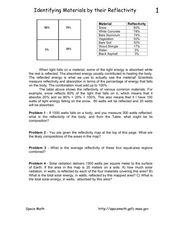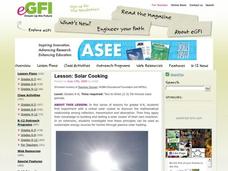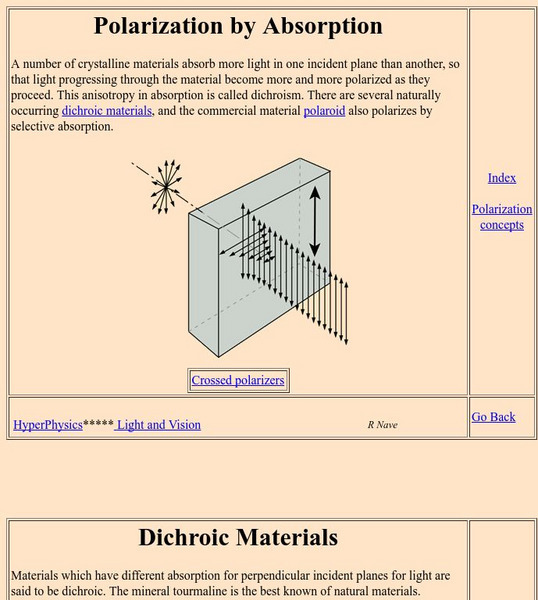Curated OER
Oceanic Absorption- Oceanic Sequestration
Students examine the techniques that may be used to reduce carbon dioxide in the atmosphere. In this pollution lesson plan students simulate oceanic sequestration using chemistry.
Curated OER
Spectroscope
Young scholars examine how to apply conservation of energy and properties of matter to a spectroscope. In this energy lesson plan students build their own spectroscope and observe three kinds of spectra.
Curated OER
Shaving Cream Art
Students participate in paper marbling. In this paper art lesson, students use shaving cream and paint to create unique patterns on paper. Students mix shaving cream and paint together then lay paper down in the mix. The paper is allowed...
Curated OER
Identifying Materials by their Reflectivity
For this reflectivity worksheet, students read about the absorption and reflectivity of light by different materials. Students solve 4 problems and determine the composition of given materials based on the amount of light reflected. They...
Curated OER
Iron in Foods
Students determine the amount of iron in a sample of cereal. In this iron lesson plan, students use a computer colorimeter to measure the amount of light absorbed by the solutions. They create a calibration curve using standard solutions...
Curated OER
Wave Actions
For this waves worksheet, students read about the ways waves react depending on the boundary they encounter. They read about natural frequency, resonance, phases and interference in waves. They match 13 terms with their definitions, they...
Curated OER
An Introduction to Light Unit-Third Grade
Third graders are introduced to light in an eight part unit which includes activities, additional resources, and rubrics for each part. Students address topics such as energy, reflection, absorption, and refraction through hands-on...
Curated OER
Modeling Hot and Cold Planets
Students, in teams, design and construct models of two planets, one hot and the other cold, using a variety of materials. They attempt to create the models out of substances that will actually show the greatest temperature differences...
Curated OER
Heat Absorption and Radiation
Learners experiment with the concepts of absorption and reflection of radiant energy.
Curated OER
Blinded by the Light
Students recognize that the colors they see are a result of the reflection of light. In this light and color lesson plan, students predict what color will be produced when lights are mixed. They identify the three primary colors and...
Curated OER
Solar Cooking
Students experiment with a virtual solar cooker to discover the relationship between reflection, transmission, and absorption. In this solar cooking lesson students apply what they learn to construct their own solar cooker.
Curated OER
Importance of Digestion
In this digestion worksheet, students complete statements using researched information about digestion and the digestive system. Students also sketch several figures that relate to digestion.
Curated OER
Energy Resources
In this energy resources worksheet, students read about the greenhouse effect and global warming. Then they explain why scientists are so concerned with greenhouse gases. Students also describe how global warming affects people worldwide.
Curated OER
Colorimetric Determination of the Concentration of Blue Food Coloring in Sport Drinks
Seventh graders determine the amount of blue food coloring in sports drinks and plot the concentration and absorbance data. They summarize the data and determine why companies need to know the amount of chemicals in their products.
Curated OER
Adventures With Super-Absorbers and Substance Solubility
Students understand the concepts of absorption, swellability and solubility and recognize that science is all around us in our everyday lives and is fun to explore.
Curated OER
How Does Light Interact With Matter?
In this light worksheet, students will brainstorm problems associated with the interaction of light with matter. Then students will write in possible solutions to those problems in this graphic organizer.
Curated OER
Suck It Up
Students investigate the "wicking capacity " of fabric; that is how well various fabrics draw water "perspiration" away from the body and let it vent to the outside. They brainstorm possible protocols to measure, tabulate and analyze the...
Curated OER
Spectrophotometry Lab
Students use a machine called a spectrophotometer to determine how much light is absorbed by certain substances. Students record the absorbance and the % of light transmitted for different color solutions, graph their results, and then...
Curated OER
Frozen Film
Students are introduced to the topic of light interference through this hands-on activity. They observe how light reflects off two surfaces and then meets to form an interesting variation of color on a film surface.
Georgia State University
Georgia State University: Hyper Physics: Polarization by Absorption
The operation of Polaroid filters on a pair of sunglasses is shown.
National Cancer Institute at the National Institutes of Health
Seer Training Modules: Introduction to the Digestive System
Self-guided learning activity where students learn about the structure and function of the human digestive system. There is a short quiz at the end of the lesson to check for understanding.
University of Colorado
University of Colorado: Ph Et Interactive Simulations: Lasers
Learn about absorption and emission by creating a laser. Pump the chamber with a photon beam, and manipulate the energy states of the laser's atoms to control its output.
University of Colorado
University of Colorado: Physics 2000: Spectral Lines
Several pages from an excellent site which describe the science of spectroscopy. The unique atomic emission (and absorption) line spectrum of elements are illustrated and explained. Includes a Java applet depicting the quantum energy...
University of Colorado
University of Colorado: Ph Et Interactive Simulations: Molecules and Light
An interactive simulation that teaches about molecules, photons, and absorption by exploring how light interacts with molecules in our atmosphere. Through this simulation students can get a better understanding of the importance of the...
























